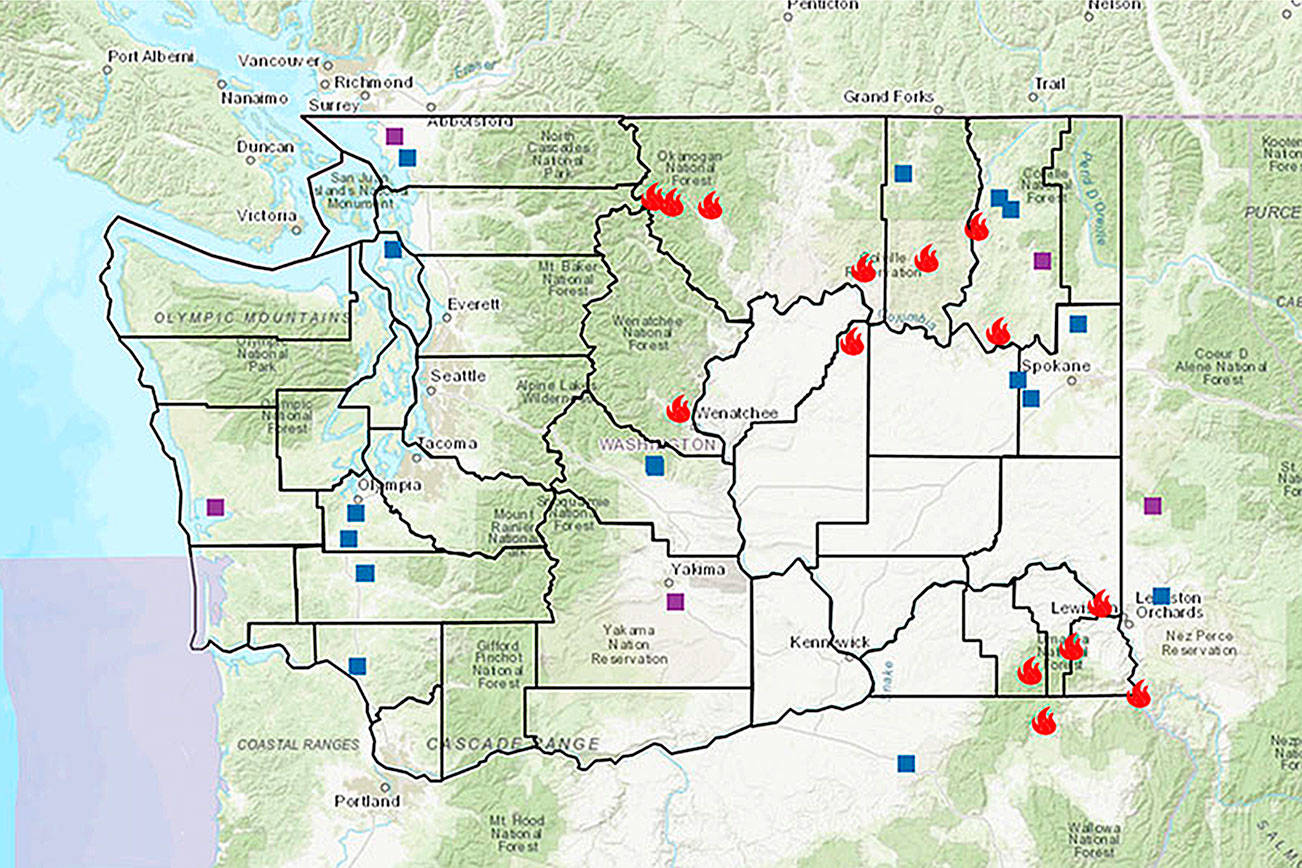Washington state already has had more wildfires than ever before.
With dry, hot weather not usually seen until August, there are 10 large fires burning across the state. That doesn’t even include the usual seasonal fires on a smaller scale said Janet Pearce, communications manager for the state Department of Natural Resources.
In July alone, DNR responded to 200 fires in the state. That doesn’t bode well for the remainder of the season. Along with the rest of the state, Kitsap County is proactively working to prevent and mitigate wildfires.
“We are really concerned with the wildland season,” South Kitsap Fire and Rescue Chief Jeff Faucett said.
On July 14, Gov. Jay Inslee issued a statewide drought declaration. With no precipitation predicted in the seven-day forecast, the dry conditions continue to be a concern. According to the US Drought Monitor, Kitsap County is being classified as “abnormally dry” as of July 20.
On the west side of the state, Pearce said the different fuel loads, such as trees and undergrowth, mean a fire could quickly spread. Those factors mean a worsening wildfire season is likely as the summer goes on.
Fire districts in the county have specially trained wildland firefighters who can be sent to other blazes across the region to assist, as well as to manage fires in their own districts. When called, districts don’t sent all their resources; the need at home is too great.
When wildfires begin to overflow firefighting resources, it’s all hands on deck. DNR will pull in partners from as far as Australia to assist, Pearce said.
While SKFR has 15 specially trained staff for wildland firefighting, Faucett said all career and volunteer firefighters have received training should they be needed.
The increase in wildfires is a troubling trend, Faucett said. Over the past seven or so years, he has seen an increase in wildfire smoke in the area. “I don’t think any of us can deny that [wildfires have gotten worse,]” Faucett said.
Pearce said only a small minority of residents in Western Washington had air conditioning installed in their homes. Now, however, it’s becoming a near-necessity. Hotter-than-usual temperatures in the region not only make for an uncomfortable summer, but they also contribute to the wildfire problem.
Central Kitsap Fire and Rescue Chief John Oliver gave a presentation on July 15 about how residents can respond to wildfires. Oliver said residents must be ready to jump into action in case fire crews are unable to respond.
One memory trick residents can use for responding to a fire is “Ready, Set, Go.” In the “ready” step, residents should have an evacuation plan and checklist of supplies, such as portable phone chargers and fire extinguishers for small fires, and know where to shut off the gas and electricity, Oliver said.
“Set” means that once there is a fire, residents should gather all flammable items and bring them inside their home or garage space, connect the garden hoses and leave ladders near their home for firefighters to use. Exterior lights should be left on for better visibility and a vehicle should be packed with an emergency kit inside, parked near an exit, the chief said.
Finally, residents should leave when they feel threatened, even if an evacuation order has yet to be issued.
Both Oliver and Faucett said that having 30 feet of defensible space around the home is vital so that fire can’t quickly spread to your house. Gutters need to be cleared of brush and debris. To date, 247 fires in the state this year were fed by debris, according to the DNR’s fire information website.
Also, smoke from fires across the region can affect your health. Faucett said smoke increases calls to 9-1-1 by people with respiratory issues.
Pearce said smoke from wildfires is staying mostly on the east side of the state. Where the smoke goes depends on the wind. But that can change in an instant, darkening skies and making the air unsafe to breathe.
Chemicals and gases mixed in the smoke clouds pose a risk to residents, said Dr. Peter Barkett, an internal medicine physician at the Kaiser Permanente Silverdale clinic. The particulates in the smoke are especially dangerous to those with asthma, allergies and cardiovascular conditions. Barkett recommends people stay inside with doors and windows closed when there is smoke in the area.
Kitsap County is in a Phase 2 burn ban, which prohibits all outdoor recreational burning. However, barbecues that use natural gas or propane are allowed and should be used on a non-combustible surface, according to the Kitsap County government’s burn ban information website. Residents also should be cautious when disposing of cigarettes and avoiding having trailer chains drag on the highway, Faucett said.



